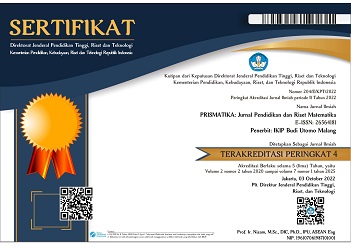KEMAMPUAN SPASIAL PERCEPTION DALAM MENYELESAIKAN MASALAH GEOMETRI BERDASARKAN TEORI VAN HIELE DITINJAU DARI KEMAMPUAN MATEMATIKA
Abstract
Difficulties in learning geometry relate to spatial abilities. Students with good spatial skills will be able to solve geometric problems. In helping students overcome difficulties in learning geometry, they used the Van Hiele's learning theory. This qualitative descriptive study aimed to describe the spatial perception ability in solving geometric problems based on Van Hiele's theory in terms of mathematical ability. The subjects in this study were three junior high school students with high, medium, and low math abilities. Subjects were given a spatial ability test and an interview twice. The triangulation time and subject was carried out to test the credibility of data. Based on the results of data analysis, students with high, medium, and low math abilities were able to observe objects from different perspectives. Subjects with medium math abilities were able to observe the object from different perspectives. However, subjects with high and low math abilities have some difficulties in observing objects from different perspectives.
References
Asryana, A., Sanapiah, S., & Kinasih, I. P. (2017). Pengembangan Media Pembelajaran Interaktif Menggunakan Geogebra Untuk Meningkatkan Kemampuan Spasial Siswa. Media Pendidikan Matematika, 5(2), 107. https://doi.org/10.33394/mpm.v5i2.1836
Azustiani, H. (2017). Kemampuan Spasial Siswa Smp Kelas VIII Ditinjau Dari Kemampuan Matematika Siswa Di Smpn 1 Semen. Simki-Techsain, 01(05), 12.
Farisdianto, D. D., & Budiarto, M. T. (2014). Profil Kemampuan Spasial Siswa SMP dalam Menyelesaikan Masalah Geometri Ditinjau dari Perbedaan Kemampuan Matematika. Jurnal Ilmiah Pendidikan Matematika, 3(2), 77–84.
Febriana, E. (2015). Profil Kemampuan Spasial Siswa Menengah Pertama (SMP) dalam Menyelesaikan Masalah Geometri Dimensi Tiga Ditinjau dari Kemampuan Matematika. Jurnal Elemen, 1(1), 13. https://doi.org/10.29408/jel.v1i1.78
Guzel, N., & Sener, E. (2009). High school students’ spatial ability and creativity in geometry. Procedia - Social and Behavioral Sciences, 1(1), 1763–1766. https://doi.org/10.1016/j.sbspro.2009.01.312
Ingri Y.M. Lalan, RullyCharitasIndra Prahmana, P. J. (2017). Penggunaan Alat Peraga Polydron Frameworks pada Materi Geometri Untuk Meningkatkan Kemampuan Spasial Matematis Siswa SMP Kelas VIII. IEEE International Conference on Acoustics, Speech, and Signal Processing (ICASSP) 2017, 41(2), 84–93.
Junsella Harmony, R. T. (2012). Pengaruh Kemampuan Spasial terhadap Hasil Belajar Matematika Siswa Kelas Vii SMP Negeri 9 Kota Jambi. 02(April), 11–19.
Ma’Rifatin, S., Amin, S. M., & Siswono, T. Y. E. (2019). Students’ mathematical ability and spatial reasoning in solving geometric problem. Journal of Physics: Conference Series, 1157(4). https://doi.org/10.1088/1742-6596/1157/4/042062
Muhassanah, N., Sujadi, I., & Riyadi. (2014). Analisis Keterampilan Geometri Siswa Dalam Memecahkan Masalah Geometri Berdasarkan Tingkat Berpikir Van Hiele. Jurnal Elektronik Pembelajaran Matematika, 2(1), 54–66. Retrieved from http://jurnal.fkip.uns.ac.id
Musa, D., & Aditya, L. (2014). Deskripsi Level Berpikir Geometri menurut Teori Van Hiele berdasarkan Kemampuan Geometri dan Perbedaan Gender pada Siswa Kelas VII SMP Negeri 8 Parepare. 4(2), 103–116.
Purwosetiyono, F. D. (2011). Implementasi Perangkat Pembelajaran Matematika Dengan Strategi Pikat Berbantuan Cd Pembelajaran Dan Lks Pada Materi Dimensi Tiga Siswa Kelas X. Aksioma, 2(1).
Syahputra, E. (2013). Peningkatan Kemampuan Spasial Siswa Melalui Penerapan Pembelajaran Matematika Realistik. Jurnal Cakrawala Pendidikan, 3(3), 353–364. https://doi.org/10.21831/cp.v3i3.1624
Tosto, M. G., Hanscombe, K. B., Haworth, C. M. A., Davis, O. S. P., Petrill, S. A., Dale, P. S., Kovas, Y. (2014). Why do spatial abilities predict mathematical performance? Developmental Science, 17(3), 462–470. https://doi.org/10.1111/desc.12138
Yanty Putri Nasution, E. (2017). Meningkatkan Kemampuan Spasial Siswa Melalui Pembelajaran Geometri Berbantuan Cabri 3D. M A T H L I N E : Jurnal Matematika Dan Pendidikan Matematika, 2(2), 179–194. https://doi.org/10.31943/mathline.v2i2.45







.png)




